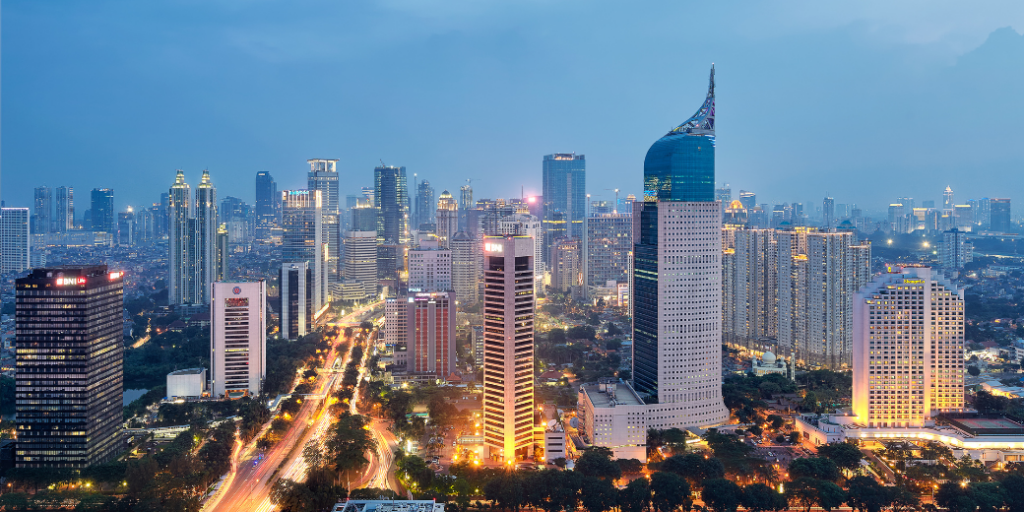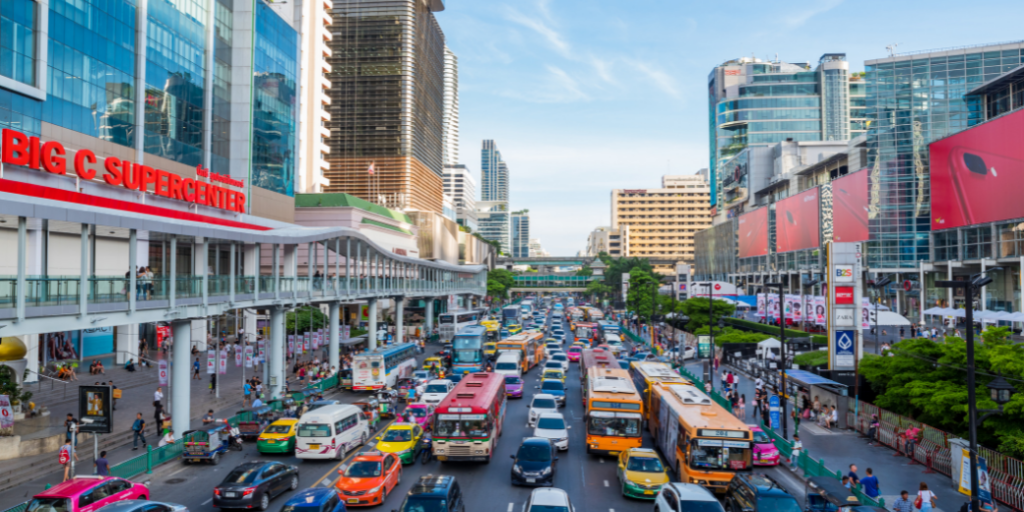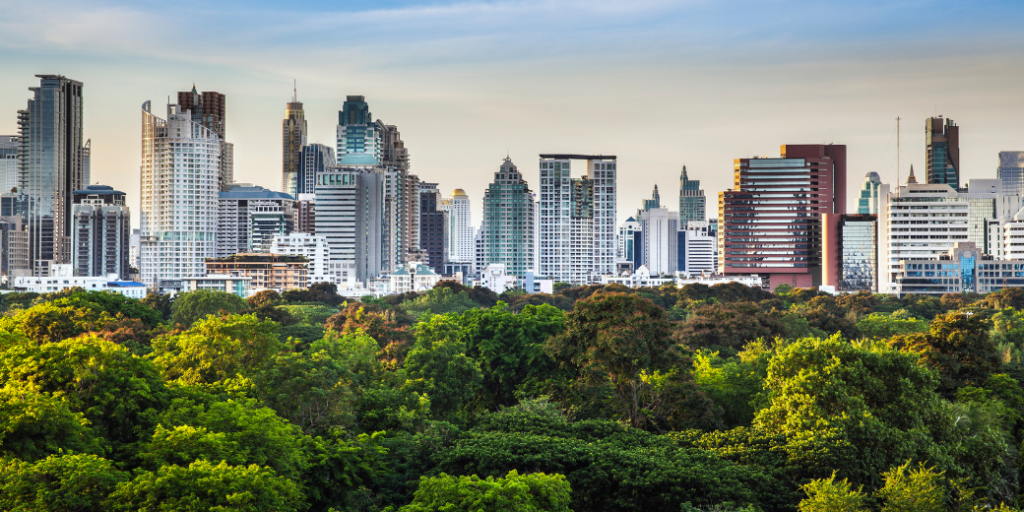Trend Reports
Thailand’s Economic Landscape in 3Q24

Summary
This article presents an excerpt from Speeda’s latest Thailand macroeconomic report, offering valuable insights into the country’s economic landscape. Gain a deeper understanding of Thailand’s latest Insights.
To access the full report with insights of short- to mid-term macroeconomic developments, along with a dynamic PESTEL analysis, sign up for a free trial and enjoy unlimited access to all our reports during the trial period.
Apply for a Trial here.
GDP Growth Surpassed Forecasts but Slowed Down
Thailand’s GDP expanded by 3.5% YoY in 3Q24, exceeding the projected 2.6% despite slowing from 4.2% in 2Q24. On a quarterly basis, GDP grew 2.2%, driven by public investment recovery and export growth.
Key Indicators:
- Public Investment Recovery: After six consecutive quarters of contraction, public investment rebounded, increasing 25.6% QoQ. Government investment soared by 43.1% QoQ, while state-owned enterprise investments saw a marginal 1.1% decline.
- Export Growth: Thailand’s trade deficit improved, supported by strong exports in electrical machinery, industrial equipment, and agricultural products. The manufacturing sector played a vital role, benefiting from higher global demand for semiconductors and computing equipment.
- Tourism Sector Recovery: The accommodation and food services sector surged by 12.6% YoY, driven by increased international tourist arrivals. The rebound in tourism also supported wholesale and retail trade, which grew 5.0% YoY.
- Private Consumption Slowed: Despite a recovery in key sectors, private consumption growth declined to 3.4% in 3Q24 from 4.9% in 2Q24, reflecting cautious consumer sentiment and rising household debt concerns.
- Private Investment Declined: Business confidence weakened, leading to a 2.5% QoQ drop in private investment. This was attributed to high borrowing costs and global economic uncertainties, particularly in manufacturing and real estate.
- Top industries by GDP contribution: Manufacturing grew by 0.2% YoY, driven by electronic components and computing equipment. Wholesale and Retail Trade expanded by 5% YoY, bolstered by domestic consumption and tourism. Construction emerged as a high-growth sector with a 15.9% YoY increase, fueled by public construction initiatives.
Source: NESDC | Trading Economics | Krungsri Research | Bangkok Post
Key Challenges Facing the Thai Economy in 3Q24
| Trade Deficit: Persistent Despite Narrowing
Thailand’s USD 1.4 billion trade deficit remains a concern despite gradual improvements. High import values, particularly for energy and industrial inputs, continue to outweigh export gains.
- Energy dependency increases external vulnerability, even as a stronger Thai baht has lowered import costs.
- Electronics and machinery exports helped narrow the deficit, but traditional sectors like agriculture and automotive faced slow recovery.
- Global supply chain disruptions and geopolitical tensions add further uncertainty to Thailand’s trade balance.
Source: Trading Economics | Prachachat| Trade Map | Bangkok Post
| Sluggish Global Demand Hurting Key Export Sectors
Thailand’s export-driven economy remains vulnerable to weak global demand, particularly in automotive and petrochemicals.
- Electronics and semiconductors saw gains, but other manufacturing exports declined due to slower recovery in China, the U.S., and the EU.
- Geopolitical tensions and supply chain uncertainties have made foreign trade more unpredictable.
- A stronger Thai baht has made exports more expensive, reducing competitiveness in international markets.
| Low Inflation Signaling Weak Consumer Spending
Inflation remained below the BOT’s 1-3% target, standing at 0.8% in October 2024. While stable prices benefit consumers, weak domestic demand is a growing concern.
- Core inflation at 0.6% suggests slow household spending as private consumption growth fell from 4.9% in 2Q24 to 3.4% in 3Q24.
- Real estate, retail, and hospitality sectors face pricing pressure due to cautious consumer sentiment.
- Rising household debt and economic uncertainty are limiting discretionary spending.
| Mitigation Measures: Policy Interventions
To counter these challenges, the BOT and government have taken key measures to stimulate the economy.
- BOT cut interest rates to 2.25%, the first reduction since 2020, to boost borrowing and investment.
- Public investment surged 25.6% QoQ, reversing six quarters of contraction, with major spending on infrastructure and digital development.
- The government prioritised FDI in high-value industries, including semiconductors and advanced manufacturing, to drive long-term economic growth.
Growth Factors Driving Thailand’s Economy in 3Q24
Thailand’s economy in 3Q24 was driven by government initiatives, industry expansion, export recovery, and infrastructure investments. These factors collectively supported GDP growth, despite external and domestic challenges.
| Government Initiatives Supporting Growth
Public Investments Rebounding Strongly
Thailand’s public investment surged by 25.6% QoQ, marking a sharp recovery after six consecutive quarters of contraction. This was driven by:
- Government Investment Surging 43.1% QoQ: Increased spending on transportation, smart city projects, and industrial zones helped sustain growth momentum.
- State-Owned Enterprise Investment Declining 1.1% QoQ: While public sector investments soared, state-owned enterprises saw a slight decline, indicating the need for further private sector collaboration.
Policy Adjustments Stimulating the Economy
The Bank of Thailand (BOT) cut the policy rate by 25 basis points to 2.25%, marking the first reduction since 2020. This move aimed to:
- Lower borrowing costs for businesses and households, encouraging spending and investment.
- Boost private sector confidence, especially in manufacturing and real estate, where capital-intensive projects benefit from lower interest rates.
- Maintain inflation within the target range, ensuring price stability while supporting economic expansion.
| Industry Growth: Strong Expansion in Construction & Services
Several industries experienced significant growth in 3Q24, contributing to overall economic expansion:
Construction: Fastest-Growing Sector at 15.9% YoY
Thailand’s construction industry saw a 15.9% YoY surge, largely due to:
- Government-backed infrastructure projects, including roads, rail networks, and public buildings.
- Increased private sector investments in residential and commercial developments, supported by lower interest rates.
- Strong demand for industrial spaces as Thailand positions itself as a logistics and manufacturing hub in ASEAN.
Accommodation & Food Services: Strong Recovery at 12.6% YoY
Thailand’s tourism sector continued its rebound, driving accommodation and food service growth by 12.6% YoY. This was supported by:
- Higher international tourist arrivals, leading to increased hotel occupancy and restaurant demand.
- Visa reforms and tourism incentives, which attracted visitors from China, India, and ASEAN nations.
- Expansion of luxury and premium hospitality services, catering to high-spending travellers.
Wholesale & Retail Trade: Growth Driven by Domestic Demand
The wholesale and retail trade sector grew by 5.0% YoY, benefiting from:
- Rising consumer spending linked to tourism recovery.
- Growth in e-commerce and digital retail platforms, enhancing accessibility for local businesses.
- Increased demand for premium goods and health-conscious products, reflecting evolving consumer preferences.
Manufacturing: Modest Expansion at 0.2% YoY
Despite facing global demand uncertainties, the manufacturing sector expanded by 0.2% YoY, mainly due to:
- Growth in electronics and industrial machinery, aligning with regional supply chain shifts.
- Investment in semiconductor production, reinforcing Thailand’s role in high-tech manufacturing.
| Export Growth: Trade Balance Improving
Thailand’s trade deficit narrowed in 3Q24 as exports outpaced import growth. While global trade conditions remain volatile, Thailand’s export recovery was supported by a competitive baht exchange rate and diversified trade agreements.
Key Sectors Driving Export Performance
- Electronics and industrial equipment exports surged, reflecting demand in global supply chains.
- Agriculture and processed food exports remained stable, benefiting from government support for the sector.
- Automotive exports faced mixed performance, with stronger regional demand offset by weak European orders.
| Public Infrastructure Investments Driving Long-Term Growth
The Thai government remains committed to expanding public infrastructure to enhance economic resilience and long-term competitiveness.
Key Infrastructure Projects in 3Q24
- Major transport and logistics developments, including high-speed rail, expressways, and port expansions.
- Smart city investments, enhancing urban development and digital transformation.
- Industrial zone expansions, strengthening Thailand’s position as an FDI hub for high-tech industries.
Source: NESDC | Trading Economics | Krungsri Research | Bangkok Post
Future Outlook for Foreign Investors
| Economic Predictions
- GDP Growth: Expected at 2.6% YoY in 2024, supported by government spending and tourism recovery.
- Inflation: Projected to rise slightly to 0.5% in 2024 and 1.2% in 2025, ensuring price stability.
- Exports: Forecast to grow by 3.8% in 2024, benefiting from a global trade rebound.
| Fiscal Policies Supporting Investment
- Continued infrastructure expansion and digital innovation will be key to sustaining long-term growth.
- Tax incentives and regulatory reforms will attract foreign direct investment (FDI) in high-value industries.
Advantages & Risks for Foreign Investors
Advantages:
- Strategic ASEAN Location: Thailand serves as a logistical hub for regional trade.
- Government Incentives: Tax benefits in electronics, renewable energy, and advanced manufacturing.
- Robust Infrastructure Development: Major projects in transport and logistics create new investment opportunities.
Risks:
- Political Volatility: Uncertainty in government stability could deter cautious investors.
- Export Competitiveness: The strong Thai baht and weak global demand may challenge sustained export growth.
- Aging Population: Labor shortages and rising welfare costs may impact long-term productivity.
Accelerate Your ASEAN Country Research with Speeda
The detailed country report above is just one example of how Speeda can save users hours of research and analysis, delivering ready-to-use insights at your fingertips. Speeda is your one-stop platform for comprehensive ASEAN business research. Whether you’re analysing countries, industries, or financial data—including insights on private companies—Speeda simplifies your workflow.
Its extensive database covers over 10 million public and private companies, 560 industries, and integrates insights from 2,000 media sources. Access proprietary industry reports, global M&A deals, and even consult an expert network service to gain the depth and precision needed for informed decision-making.
From conducting peer comparisons to sourcing high-value deals, Speeda empowers professionals in private equity (PE), investment banking, consulting, and beyond. The advanced search filters, macroeconomic overviews, and proprietary reports allow users to dive into ASEAN-specific trends and emerging opportunities faster and more effectively than ever before.
Unlock Actionable Insights with Speeda
Sign up for a free trial today to explore the full report on Thailand’s Economic Landscape in 3Q24 and access a treasure trove of region-specific reports saved in our database. Transform your ASEAN research with Speeda.









